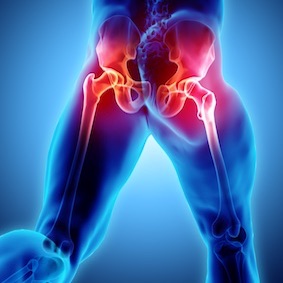What is Osteoarthritis?
Osteoarthritis is a condition of the joint, most often occurring in hips and knees. Nearly a million Dutch people are affected by osteoarthritis in these joints. Osteoarthritis is a chronic and slowly progressive condition. It is called chronic because there is currently no cure for it. Slowly progressive means that the condition gradually deteriorates. Often, symptoms only start to develop when the condition of the cartilage has been deteriorating for a while. Osteoarthritis affects both cartilage and other structures in and around the joint, such as bone and muscles.
Osteoarthritis symptoms
Symptoms of osteoarthritis include: pain, stiffness, muscle weakness, knee instability, a crackling sound when you move, limited range of movement in your joint, inflammation of the joint, abnormal knee alignment (bow-legged or knock-kneed alignment), fatigue, finding it hard to perform activities and to maintain a daily routine.
Self-help for osteoarthritis
If you find the right way to manage your symptoms, osteoarthritis won’t become any worse or it could even improve the condition. How should you manage your symptoms? The following is important:
- Maintain the right balance between weight bearing and your body’s tolerance for weight bearing.
- Increase your body’s weight bearing tolerance through more activity and by exercising
- Reduce the load your body bears (if necessary)
- Lose weight (if necessary)
- Pain medication
- Supervised exercise
Physiotherapy or occupational therapy treatment
When you are badly affected by osteoarthritis, or are due to have surgical treatment, you can arrange to see a physiotherapist or an occupational therapist. Therapy is divided into two stages: Assessment and Treatment.
Assessment
In this stage, the therapist will discuss the best type of treatment for you. It is important that you clearly express your expectations of the treatment as well as what you aim to achieve by it. The therapist will go over your symptoms and will discuss any possible treatments for you.
For his assessment, a therapist will carry out:
- An interview
- A physical assessment
- The use of one or several measuring tools
A therapist will take as long as he needs for these three elements of the assessment in order to find out exactly which symptoms you are suffering from and to determine the type of help that is needed. Afterwards you will decide together which treatment is the right one for you.
Treatment
There are three types of treatments. Together with a therapist you will decide which one, or which combination of treatments is most suitable. Whichever treatment you choose will depend on your personal situation.
The options are
- Information and advice
- Occupational therapy
- Other types of therapy
When treatment has finished
Have you reached the goals you and the therapist had set together? In that case, the therapist and you will decide whether you should stop your treatment. It is, however, also possible to end treatment if it isn’t proving effective. The therapist can advise going back to your GP or specialist again and consider other possible treatments. During the last session, the specialist will discuss your treatment and will be interested in hearing your thoughts as well. He will also advise you what you can keep doing by yourself at home. You can also agree to make an appointment to come back after some time, to discuss how things are going on your own.
Book an appointment
Osteoarthritis Exercise Regime
Are your joints feeling stiff and painful when you move? Does that make it difficult to walk? Exercising may well be the last thing on your mind as you probably want to minimise your pain as much as possible. However, it is crucial for people with osteoarthritis to keep active. The less you move, the quicker your symptoms grow worse and daily life becomes more restricted. Various physiotherapy clinics have therefore designed an exercise regime aimed specifically at people with osteoarthritis. Your physiotherapist will use this regime to help guide you towards a more active lifestyle in a responsible manner. Exercise can improve pain and restrictions.
Why would an exercise regime be beneficial for you?
An active lifestyle will increase your quality of life. You will experience less stiffness; your level of fitness will improve, and you will learn how to exercise responsibly while allowing for your restrictions.
Which other physical complaints does FysioCity treats?
Book an appointment
 NL
NL